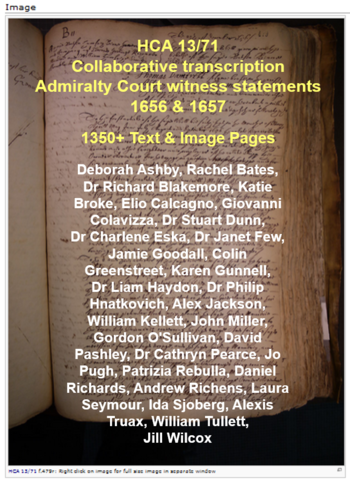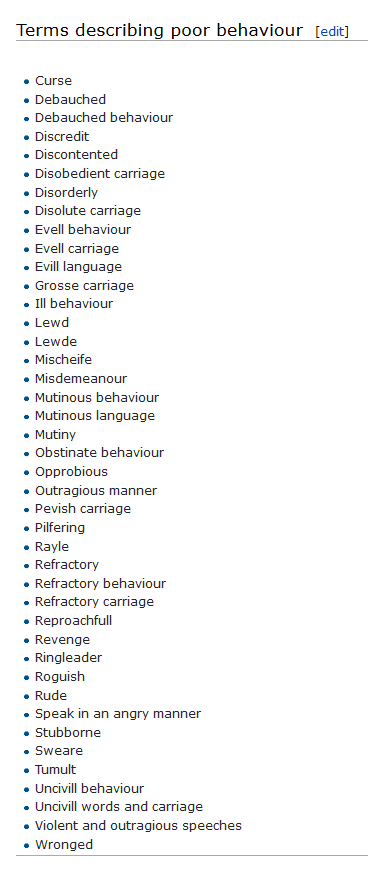FrontPage Archive
Contents
- 1 Our latest transcription challenge
- 2 Introducing our content
- 3 Curses, debauchery, mutiny and revenge
- 4 Georgius ab Ettenhart - Tesorero General de la Cruzado for Spanish monarchy (1643-1648)
- 5 Georgius ab Ettenhart, factor of Graf Fugger and Tesorero General de la Cruzado for Spanish monarchy, was a close relative of Zacharias Geizkofler (b.1560, d.1617), Reichspfenningmeister (treasurer) of the Holy Roman Empire
- 6 Juan Esćon - help us solve a mystery
- 7 Two sides of a story of privateering off the coast of Guinea
- 8 Letter from Daniel Sloyer in Cadiz to Albert Behrens in Hamburg, reporting death of Behren's brother-in-law, Vincente del Campo, January 23rd 1656
- 9 Measuring the impact of digital history
Our latest transcription challenge
HCA 13/124 is a volume of Personal Answers submitted in the English High Court of Admiralty in the years 1650 to 1652. The original manuscripts are held at the National Archives, Kew, England.
A complete set of digital images is available on this wiki, together with transcriptions of the first eighty six folios.
We are currently looking for volunteer transcribers to work with us to finish the transcription of this volume. Volunteers will be supported by an experienced trained facilitator. Novice and experienced transcribers are equally welcome.
Please contact us to learn more about working as a volunteer to complete HCA 13/124.
Introducing our content
HCA 13/71 is a volume of witness statements or depositions submitted in the English High Court of Admiralty in the years 1656 and 1657. The original manuscripts are held at the National Archives, Kew, England.
This volume was transcribed between September 2012 and March 2013 by a team of volunteer transcribers working on the MarineLives project. Full text semi-diplomatic transcriptions of the full volume are published on this wiki with associated digital images from the original manuscript volume.
Click here to access the text and images
Click here for an alphabetical list of deponents
Click here for a geographical list of deponents
Curses, debauchery, mutiny and revenge
Seventeenth century seamen of all nationalities were a boisterous lot, especially when "in drink". We have had some fun collecting some of the words used to describe poor behaviour, together with some of the rich language used amongst seamen.
We invite you to read about the Danish general's captain who told an English master of a ship that his letters of marque were "good for nothing but to wipe his breeche with" (HCA 13/72 f.218v) and another English master who was alleged "in an outragious manner" to have reviled the merchants' factor calling him "old Roague and old Pedler and old Pimpe and the like disgracefull names" (HCA 13/73 f.3r)
For more examples click here.
Take a look too at a disciplinary code drawn up in 1647 by the master of the Mayflower, an English ship engaged in the slave trade.
Georgius ab Ettenhart - Tesorero General de la Cruzado for Spanish monarchy (1643-1648)
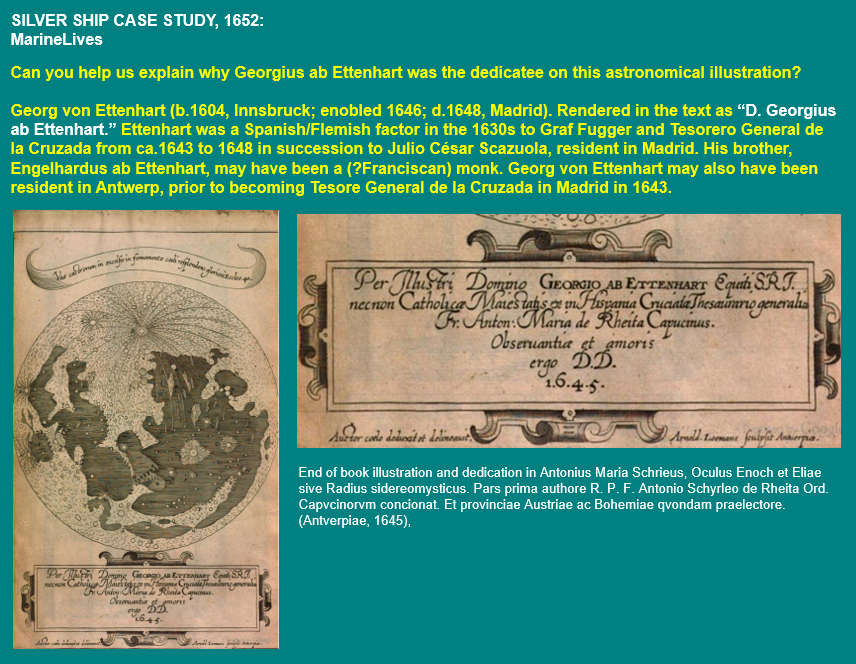
An astronomical book by Antonius Maria Schyrleus (1645) contains the following dedication: "Per Illustri Domino Georgio ab Ettenhart Equiti SRJ. necnon Catholicae Maiestatis ex in Hispania Cruciatae Thesaurario generalis Fr. Anton: Maria de Rheita Capucinus. Obseruantur et amoris ergo D.D. 1.6.4.5.".
Who was the dedicatee, and why was he so honoured? Please help us learn more about the man and his life.
What we know so far is that Georgius ab Ettenhart (b.1604, Innsbruck; d.1648, Madrid) was the Latin name of the Innsbruck born German Georg van Ettenhart, who was enobled by the Spanish monarch in 1646. In the 1630s, the same man, using the hispanicised version of his name ("Jorge van Ettenarden") was a leading Paguista on behalf of the Spanish Crown, funding military and other expenditure in the provinces of Flanders and Brabant. Ettenarden appears to have been acting together with Juan Paulo Lavaña, on behalf of the Fugger merchant-banking family.[1] Following the death of Julio César Scazuola in 1639, Ettenarden, also known as "Jorge de Hetenard", took over as Tesorería General de la Cruzada" (Treasury of the Crusado).[2]
As the deceased "George Etton Heard", he appears in the Silver Ships litigation in the English Admiralty Court (1652-1654), which is proving a rich historical source and case study linking Spain to the economies and networks of Antwerp, Amsterdam, Hamburg, and London.
You can read more about Georgius ab Ettenhart here, together with other Madrid based Assensistas, who had wool and silver on board the three Silver ships, which were seized by the English in November 1652.
Georgius ab Ettenhart, factor of Graf Fugger and Tesorero General de la Cruzado for Spanish monarchy, was a close relative of Zacharias Geizkofler (b.1560, d.1617), Reichspfenningmeister (treasurer) of the Holy Roman Empire

Zacharias Geizkofler von Gailenbach und Haunsheim (b.1560; d.1617) is the subject of a detailed entry in the online Deutsche Biographie by Ferdinand Blendinger (1964)[3] and a useful Wikipedia DE article.[4] Blendinger describes a talented youth, who studied law at the universities of Padua, Ingolstadt, Basel and Straßburg, following his schooling at the Gymnasium von Sankt Anna in Augsburg. He completed his legal education at Bourges and at the Reichskammergericht in Speyer. In 1584 he entered the service of the Fugger family, as had four of his father's brothers, but left the Fuggers in 1585, with their consent, to join the service of Erzherzog Ferdinand von Tirol. He came into close contact with the leading Habsburgs and his diplomatic skills were recognised by the Kaiser Rudolf II, who appointed him "Reichspfenningmeister des Heiligen Römischen Reichs" in 1589. The Geizkofler family archives in the Landesarchiv Baden-Württemberg contain correspondence with various members of the Fugger families from the 1680s through to Zacharias' death in 1617.[5]
The above-mentioned sources state that Zacharis Geizkofler was an imperial councillor at the Bohemian Court ("königlicher Rat am böhmischen Hof"), Reichsritter and Freiherr. From 1597 until 1603 he was Generalproviantmeister of the Imperial army in Hungary. As Reichspfenningmeister from 1589 it was his responsibility to collect the moneys for the Empire which had been approved by the Reichstag. His banking connections were put to use in terms of organising bridging finance. In his later years, having been forced out of the position of Reichspfenningmeister, he continued to advise successive emperors and chancellors on imperial finances. His son Ferdinand Geizkofler von Gailenbach und Haunsheim (b.1592; d.1653) was a contemporary of Georg von Ettenart.[6]
Zacharias Geizkofler is likely to have been related to Georg von Ettenhart, probably in multiple ways. We are still working on the exact relationship, but suspect he may have been a much older first cousin through Georg's father's sister. It is of course interesting that Georg van Ettenhart, who served as a factor for Graf Fugger in the 1630s, and then as Treasuer of the Office of Crusado for the Spanish King, was related to a man who performed an important financing function for the Holy Roman Emperor.
A web based genealogical source suggests that Zacharias Geizkofler's mother was "Barbara Ettenharterin" (sic) and that Barbara's parents were "Josef Ettenharter" and "Magdalena Flam".[7] If true, then Zacharias' mother was the sister of Engelhard ab Ettenhart, the father of Georg von Ettenhart [alt. ab Ettenhart], and Zacharias Geizkofler himself was a much older cousin of Georg von Ettenhart. Zacharias' birth in 1560 would make him forty-four years older than Georg, with his death in 1617 at the age of fifty-seven occuring when Georg was roughtly thirteen years of age.
The above would start to explain how the young George von Ettenhart became a factor for Graf Fugger in his early thirties, as is discussed by Karl Pohl (1972, 2005).[8] Zacharias Geizkofler was located in Augsburg and in his position as Reichspfenningmeister would have had excellent banking relationships with various German banking families, including the Fuggers. It is possible that documents in the Geizkofler family archive relating to Zacharias' son Ferdinand Geizkofler (b.1592, Augsburg; d.1653, Regensburg), a slightly older contemporary of Georg von Ettenhart, may contain references to Georg. These records are particularly rich for the period 1641-1646, when Ferdinand was württembergischer Statthalter and from 1644 württembergischer Hofkanzleidirektor.[9]
Juan Esćon - help us solve a mystery
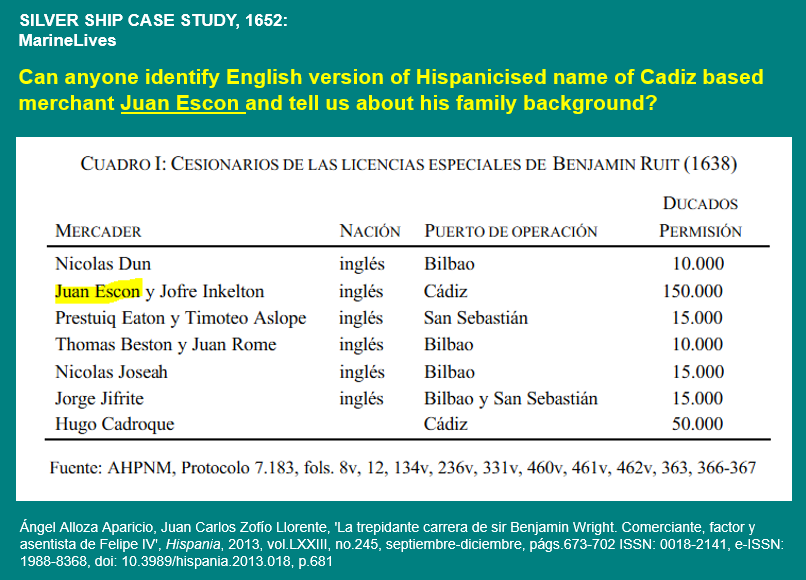
Juan Escon, also known as Juan Escout, was a Cadiz based merchant commercially active in the 1620s and 1630s, and possibly later. He was married to Margarita Enríquez, who was presumably Spanish. His daughter, Susanne Escon, married the Hamburg born merchant Vincent von Kampe, who was known in Spain as Vicento del Campo. Juan Escon and Vicente del Campo appear together in a commercial document dated 1640 for Cadiz related merchandize[10]
Juan Escon had several sons by his wife Margarita Enriquez, who were thus the (Anglo-Spanish) brothers-in-law of Hamburg born Vincent von Kampe: (1) Juan Escon Enriquez [11] (2) Pedro Escon y Enriques[12]
Vincent von Kampe played an important commercial role in litigation surrounding three Hamburg ships seized by the English in 1652 and suffered severe financial difficulties as a result of the seizures
Until recently we had believed Juan Escon to have been a native Spaniard. It now appears that he was an English merchant, who was English consul in Cadiz in the 1620s, and who was involved with the English merchant Sir Benjamin Wright in financing the Spanish Crown in the 1630s and 1640s. We are keen to identify his English name, and to understand his family origins and commercial activities. Can you help us?
Juan Escon may be the hispanicisation of an English name.
Ángel Alloza Aparicio, Juan Carlos Zofío Llorente (2013) name Juan Escon with a partner, Jofre Inkleton, and identify them as being of the "English" nation. The context is a list (as of 1638) of special licensees of Benjamin Ruit, who was the English merchant Sir Benjamin Wright, prepared from Spanish notarial protocols.

Adolfo de Castro (1857) provides background on the C17th Cadiz based "Escout" family, which appears to be synonymous with the family of Juan Escon and his successors, and which de Castro associates with the c. del Baluarte in Cadiz. He states in his entry for "BALUARTE (c. del) "A la mitad del siglo XVII se llamó de D. Juan Arnesto de Troya, regidor perpétuo que debió tener en esa calle las casas de su morada. En 1666 era concocida esta calle por de los Doblones, y en 1680 por de Juan de Escout. Este Juan de Escout obtuvo en 1637 cédula real para ejercer el cargo de cónsul de la natcion inglesa en Cádiz. Segun las actas del Ayuntamiento, en 1639 consiguió título de perpetuidad en su oficio por un donativo de cuatro mil reales hecho á S.M. En 1673 obtuvo un D. Juan del Campo y Escout título de regidor perpétuo de Cádiz. En mayo 26 de 1690 se concedió título de marquesa de Villa-Campo á doña Juana Escout y Enriquez. En instrumentos públicos aparece con el nombre de Baluarte de S. Felipe á mediados del siglo XVIII. D. Juan Escout y Margarita Enriquez habitaron en las casas del Torreon que debian hacer esquina á la plaza de este nombe. (Véase calle de la Aduana)...."[13]
Two sides of a story of privateering off the coast of Guinea
The English slaving ship the Fortune was seized off Cape Vincent on the coast of Guinea in 1657 by two Dutch ships, the Mary of Amsterdam and the Unicorn of Middleburg.
Read the English side of the story, told by the forty-two year old captain of another English slaving ship, the Rappahanack as deposed in the English High Court of Admiralty
Read the Dutch side of the story as recorded in a Dutch book of secret state resolutions
Help the Silver Ships team at MarineLives by translating the Dutch document into English and sending it to us using our contact form. We will then put up the English translation beside the Dutch original on this wiki

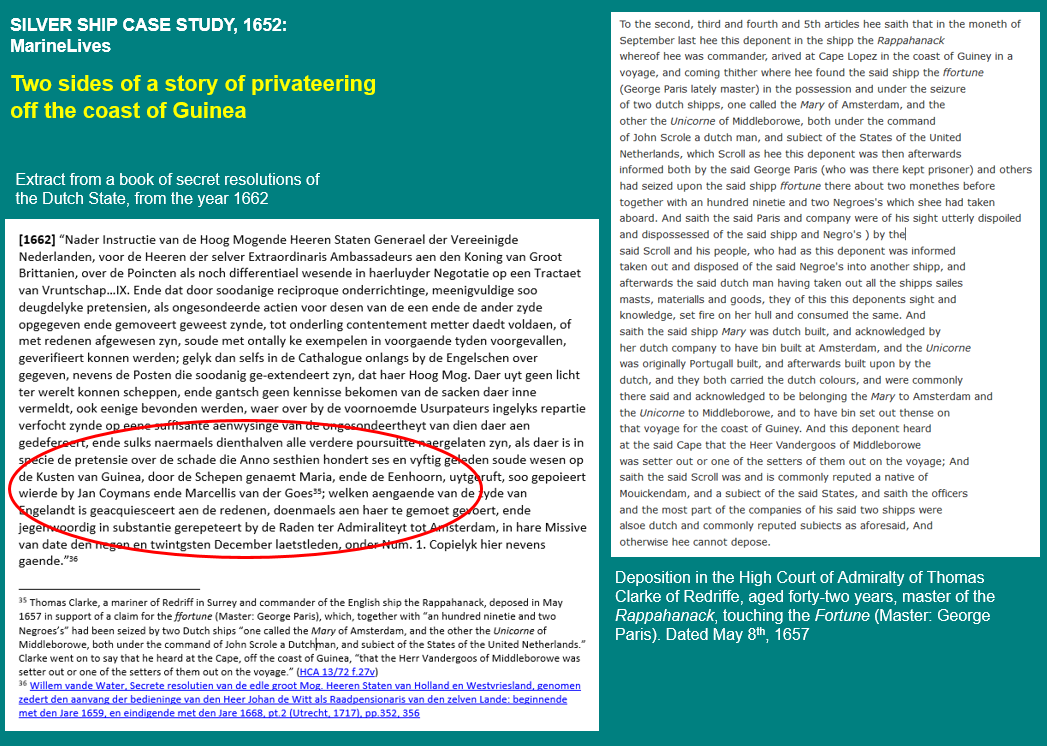
Letter from Daniel Sloyer in Cadiz to Albert Behrens in Hamburg, reporting death of Behren's brother-in-law, Vincente del Campo, January 23rd 1656
Please help us with our latest palaeographical challenge.
We have a letter from the Staatsarchiv Hamburg, written in German, by a Hamburg merchant living in Cadiz named Daniel Sloyer. He was writing to another Hamburg merchant, back in Hamburg, named Albert Behrens [alt. Berens]. The letter is dated January 26th 1656 and informs Behrens of the death in Cadiz of Vicente del Campo [alt. Vincent von Kampen], who was Albert Behrens' brother-in-law.
We have got the gist, which we publish here, but we are sure that you can improve on it.
Please Tweet your improvements to @Marinelivesorg or use our contact form to send us your suggested edits
Copia schreiben Daniel Sloyer, aus Cadiz den 23 January, Anno 1656. an H. Albert Berens in Hamburgh: Part A

[?XXX] [?Veter], [?XXXXXXXXX] [?Insonders] groβgünstiger [?herr], undt [?liebwerster] [?XXXüdt], demselben
[?meine] [?grund] [?XXXX], deβen angrur[?XXX] schreiben Von 24. November habe woll empfangen, eβ
mögen aller seiner fründs [?XX] des Elendt: und [?XXXXigen] todt des Sr. Vincent Von Campen
mitt [?fürgh] beklagen, Gott wolle [?seiner] [?Sohlen] gnädig] sein, will eβ der [?fedder] micht [?Vertrauen]
daVon [?relation?XX] [?thun] Von dem Waβ Vorgangen, undt passirt ist, umb an anders [?XXXX] [?XXX]
tragen, wir woll [?kpmanet] für seine [?XXXXXXX], wir [?XXX] aller seitt [?gethan], undt [?XXXXX]
[?mich] für ihm gesetzet in [?Colrus] gefahr, undt mitt [?zuin] aber meiner wollfahrt, undt
[?gerah?ten], Waβ ihm ge[?XXXXX], aber Er soll [?briven] [?zahtt] Von mir, [?XXX] andere [?gXXXXX] [?XXXX]
Wollen an[?XXXX], Undt [?Van] mist Viele dingen Von denselben, undt mir [?WXXXX] Vergeben
so W[?XXX] Er se[?varr] gü[?XXX], Her, undt reputation [?Were] [?üβiyh] Gott weiβ waβ
bessa[?Xxritt] [?weis] allers wirdt haben, Ich habe bey ihm gre[?X]an, daβ Gott, undt den [?XXX]
bru[?X]üst ist, [?SrXX] dispositiones auff [?XXXXry] Weiβ, seindt in seinem Erben al[?XXX
gantz [?XX] mist approbert; so [?]ire wirdt disparat seindt derselbe gru{?XXXX], maβen Er seine [?XX]
Copia schreiben Daniel Sloyer, aus Cadiz den 23 January, Anno 1656. an H. Albert Berens in Hamburgh: Part B

[?XXbrudrfraul], undt drey [?Vor]mundige Kindern, Sie Erben gemacht über seine güetter, Wan [?Er]
Aber dispa[?XXt] grut[?esen], ist ihm Sie Vergeben, [?Eβ] were besser daβ seine Correspondenten
[?rXX], waβ Er Verg[?rem], undt übell danken disponirt hatt, [?XXXurs] bedrukens [?XXβ] [?XX]
[?mieht] in seiner [?maeht] gru[?lesen] sein; wer aber Gott wegen das [?wreXXen] [?XXX] Vergeβen
dem kan eβ nicht woll gehen, den Gott läβet [?sih] nicht [?shertzen]: worin guetter herr[?XX]
undt frundt ich habe ein gre[?Xell], wan ich daran [?XXX] [?gedrucken], waβ passiert ist
Gott weiβ daβ ich [?muht] [?XXXXne] [??le] dingen [?Xxinig] [?XX] [?XXXin] [?XXXXXon] [?u] Vertr[?XX]
bitte aber Gott daβ ER seine Sohle gnädig sey, undt [?XXβ] nicht straf[?fe] in seinem [?XXX
dan Wir alle sünder sindt: [?nach] [abgelesnum] diesen brieff, bitte denselben [?zu] [?Verbrennen]
weil[?e] eβ meine Profession [?XXX] ist, [?librudigXX] [?mousten], [?Vire] [?weiniger] dem der todtist
[?XXXen] rerudigen sücces [?mag] [?sushriben], weill aber [?XXXX] [?vire] offenbahr ist, so word[?en]
Auff das herrn schreiben, undt ansui[?hen] dafur [?VXXanlaβet]. mundtlich [?wurde] [?dXX] [?herrn
Allesmitt [?XXXXrrn] [?XXXXXXX], aber wir oben g[?XXXget], Will eβ der [?XXXX] must Vertraulich
[?XXX] [?freundts grueβe [?XX] [?XXXX] [?XXXXXXX] [?XXXXXXXX] Daniel Sloyer [SIGNATURE]
Measuring the impact of digital history
| Digital history website userdata (as of 14/06/2016) | ||||
|---|---|---|---|---|
| Website | Global rank | Bounce rate | Daily time per visitor on site (mins) | Daily page views per visitor |
| http://ancestry.com | 447 | 20.00% | 28.07 | 35.97 |
| http://ancestry.co.uk | 5321 | 22.50% | 23.21 | 32.60 |
| http://oldbaileyonline.org | 318,006 | 57.70% | 5.57 | 4.70 |
| http://marinelives.org | 20,311,188 | 72.51% | 4.06 | 3.85 |
| http://british-history.ac.uk | 133,535 | 65.50% | 2.53 | 2.58 |
| http://locatinglondon.org | 3,663,143 | 88.00% | 2.35 | 1.10 |
| http://digitalpanopticon.org | 7,440,243 | N/A | 1.42 | 1.30 |
| http://manuscriptsonline.org | 4,763,161 | 47.19% | 1.37 | 1.60 |
| http://connectedhistories.org | 969,577 | 74.00% | 1.31 | 2.00 |
The MarineLives project team is working with academics at the Universities of Manchester, Oxford, Essex, London, Saint Andrews and Leiden to explore the creation of a C17th legal ecosystem. We are considering making a consortium bid for UKRC funds in response to the current CFP: "Content Creation and consumption in the Digital Economy", to create such an ecosystem, together with a set of digital tools to mine and enrich the data within this ecosystem. Our vision is to build off MarineLives' successful model of facilitated team based collaboration between academics and non-academics.
We are also thinking how we would measure the impact of such an ecosystem, and have started to explore possible measures. The data we display here rank a number of leading digital history projects and search engines, together with several family history sites.
We would welcome your comments both on the data, and on what measures are most relevant in thinking about the impact of digital history projects. Please post your comments to Twitter, including our tag @marinelivesorg or send them using our contact button here.
You can also contribute to the discussion of how to measure the impact of digital history projects and help to shape our thinking, by joining a discussion seesion we are holding on Academia.edu. There are many interesting participants, including Richard Price, founder and chief executive of Academia.edu. You can access the session by clicking here
- ↑ Hans Pohl, Zur Bedeutung Antwerpens als Kreditplatz im beginnenden 17. Jahrhundert’ in Hans Pohl, Wirtschaft, Unternehmen, Kreditwesen, soziale Probleme, vol.1 (Stuttgart, 2005), pp.135-138
- ↑ Álvarez Nogal, Carlos, Los banqueros de Felipe IV y los metales preciosos americanos (1621-1665), Banco de España – Servicio de Estudios, Estudios de Historia Económica, no.36, 1997, p.117
- ↑ Onlinefassung, based on Blendinger, Friedrich, "Geizkofler von Reiffenegg, von und zu Gailenbach, Zacharias" in: Neue Deutsche Biographie 6 (1964), S. 167 f.
- ↑ Wikipedia DE article: 'Zacharias Geizkofler'
- ↑ Landesarchiv Baden-Württemberg: 9. Beziehungen der Geizkofler zu anderen auswärtigen Herrschaften und Adligen: 9.4 Beziehungen zu Grafen, anderen adligen Herren und städtischen Patriziern (A-Z): 9.4.3 Füeger von Hirschenberg - von Gemmingen
- ↑ Wikipedia DE article: 'Zacharias Geizkofler'
- ↑ Verein für Computergenealogie: 'Barbara Ettenharterin'
- ↑ Hans Pohl, 'Zur Bedeutung Antwerpens als Kreditplatz im beginnenden 17. Jahrhundert' in Hans Pohl, Wirtschaft, Unternehmen, Kreditwesen, soziale Probleme, vol.1 (Stuttgart, 2005), pp.135-138
- ↑ Landesarchiv Baden-Württemberg, Abt. 5. Staatsarchiv Ludwigsburg: 8. Beziehungen der Geizkofler zu Württemberg: 8.2 Unter Ferdinand Geizkofler (insbesondere während seiner württembergischen Statthalterschaft), 1641-1646; Wikipedia DE article: 'Ferdinand Geizkofler'
- ↑ Archivo General de Indias: ES-AGI-41091-UD-1859526 - ES-AGI-41091-UD-273566: Scope and content: Real Cédula aprobando la escritura de venta del 1 1/4% cobrado de las mercancías que entraren y salieren de Cádiz, hecha en nombre de S.M. por el presidente de la Contratación a favor del almirante Pedro de Ursua, Juan de Marte, Manuel de Iribarri, Baltasar Fernández Franco, Juan Bravo de Laguna, Juan Escon, Vicente del Campo, Benito Gómez etc, por el precio de 295.383 ducados y medio (fol.202). Acomp. Testimonio de dicha escritura de venta, condiciones y otros documentos sobre el asunto: Date: 30th May 1640
- ↑ Archivo General de Indias: ES-AGI-41091-UD-1859528 - ES-AGI-41091-UD-152527 Scope & content: Expediente de información y licencia de pasajero a indias de Juan Escón Enríquez, mercader, natural y vecino de Cádiz, hijo de Juan Escón y de Margarita Enríquez, a Tierra Firme, Date: 5th Feb. 1675
- ↑ Archivo General de Indias: ES-AGI-41091-UD-1859528 - ES-AGI-41091-UD-151522 Scope and content: Expediente de información de Pedro Escón y Enríquez, mercader, natural de Cádiz, hijo de Juan Escón y de Margarita Enríquez, a Tierra Firme. No hay licencia ni Real Cédula. Fecha final; Date: 23rd Sept. 1664
- ↑ Adolfo de Castro, Nombres antiguos de las calles y plazas de Cádiz: sus orígenes, sus cambios, sucesos notables ocurridos en ellas, idea de la antiguas costumbres locales (Cádiz, 1857), p.7
